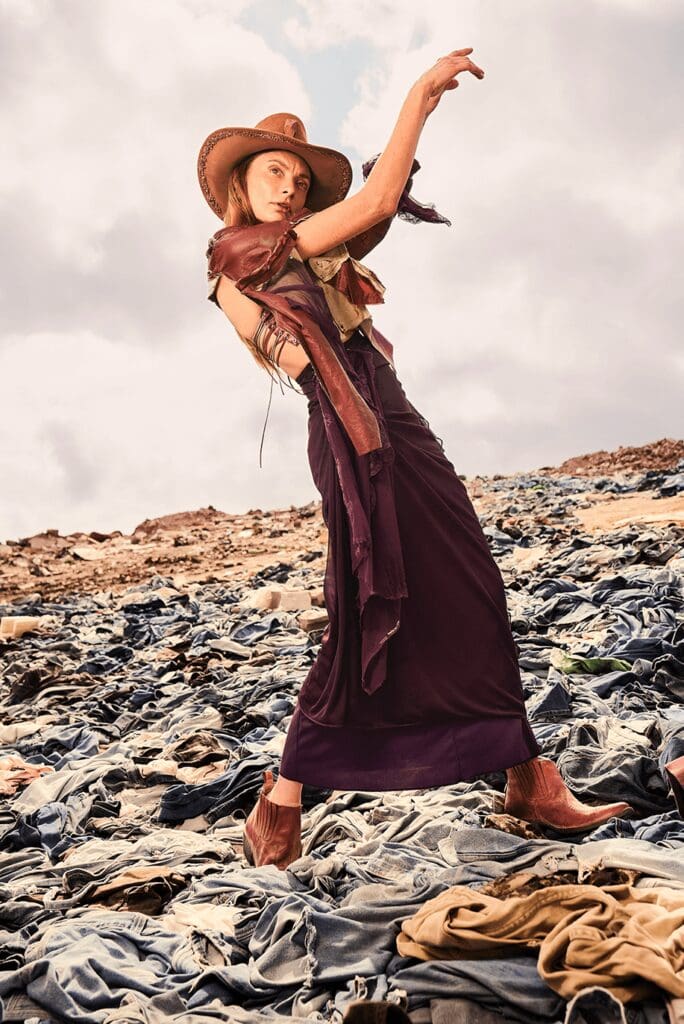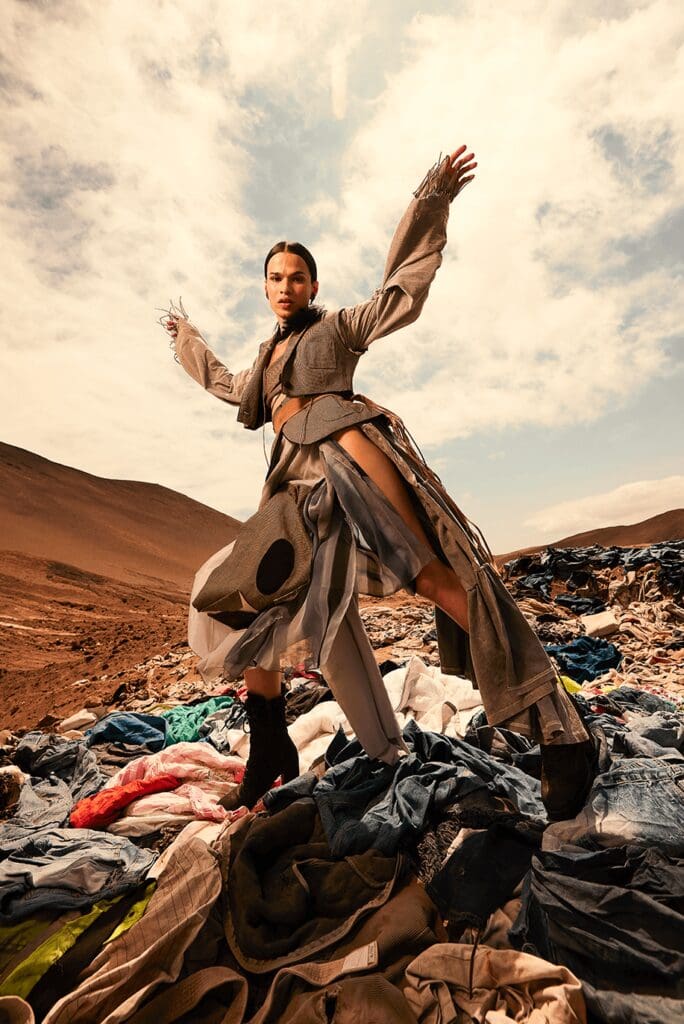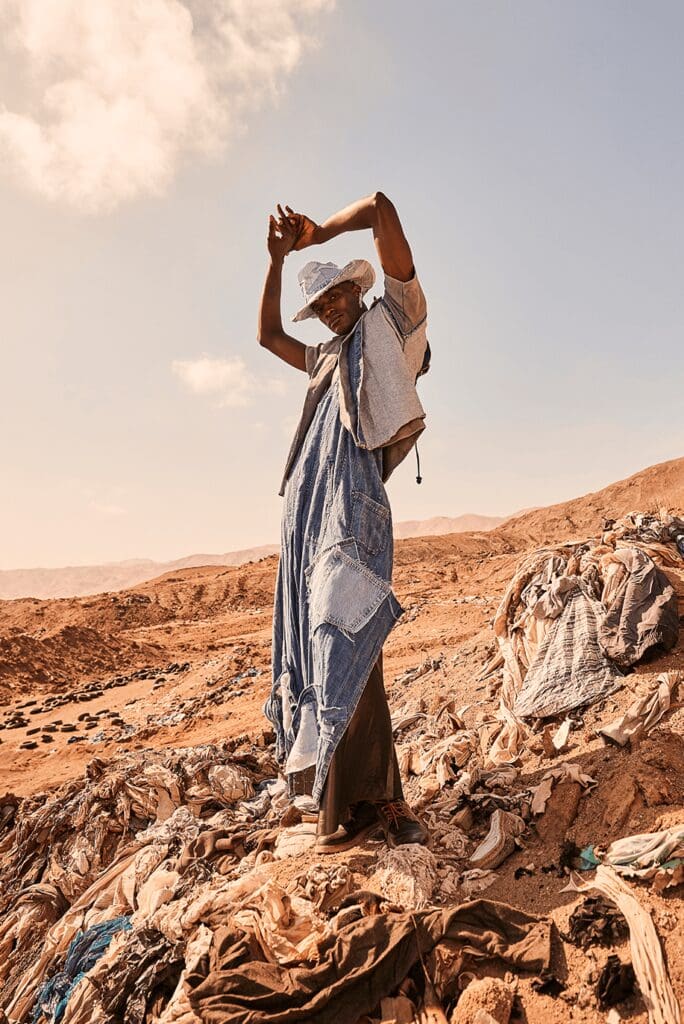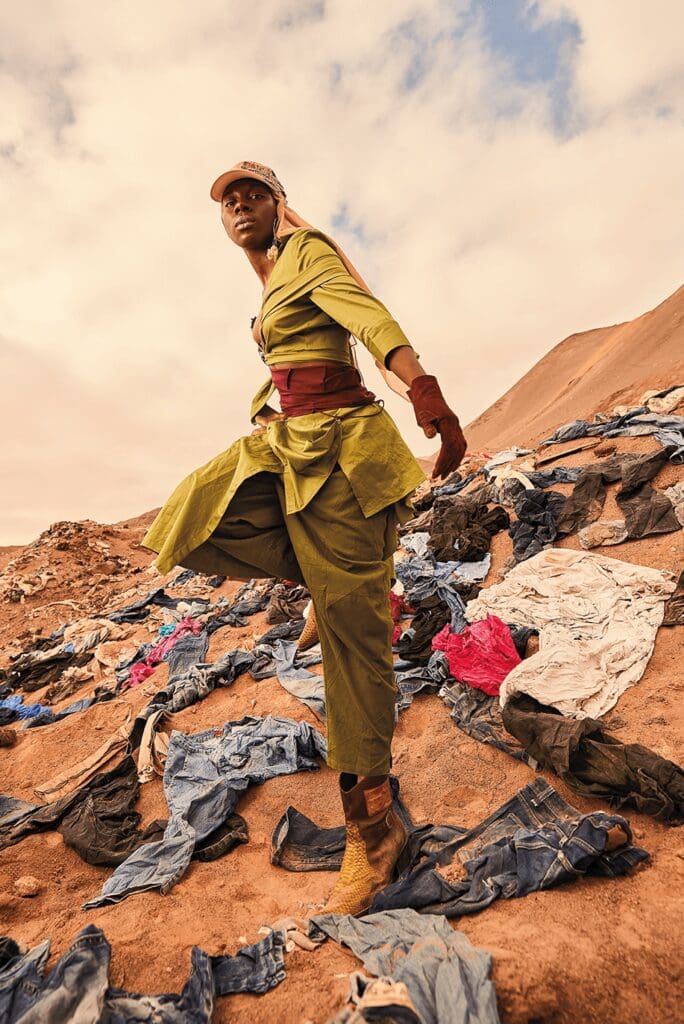Have you heard of the Atacama Desert? It’s located in Chile and is the driest non-polar desert in the world. It is nestled between the Pacific Ocean and the Andes Mountains. It boasts stunning oases, volcanoes and moonscapes as well as hot springs and dreamy desert-chic hotels, among more natural beauty. It sounds beautiful, doesn’t it? The truth is, it also has a dirty secret that has been created by you and me. The Atacama Desert is also the world’s largest fashion landfill. It is referred to as the Fast Fashion Graveyard.
Every year, roughly, 40,000 to 60,000 tons of clothing are imported to the area of Alto Hospicio in the Atacama Desert. The town sits on a cliff above the Pacific Ocean where containers full of discarded clothing are unloaded from ships and packed onto trucks and dumped illegally. According to Wired magazine, “Chile is the biggest importer of secondhand clothing in South America, and between 2020 and 2021 it was the fastest-growing importer of used clothing in the world. The port of Iquique is an established tax-free zone, incentivizing this booming industry of castaway textiles.”

In 2021, an aerial view image of the area went viral. The picture was of mountains of used clothing that had been discarded in the desert. A mountain so vast it could be seen from space. It was estimated that more than 100,000 tons of clothing had accumulated in the illegal landfill over 18 years. So where did these clothes come from? The Global North. Our fashion cast-offs of trends past are shipped to places like the Atacama Desert. While some items are resold in Chile’s secondhand market, the unsellable clothes are sent to landfill. The mountain is littered with labels like H&M, Adidas, Zara, Shein, Levis, Forever 21, Ralph Lauren and so many more. Brands’ overproduction and our overconsumption is filling up landfills globally and causing an unimaginable negative environmental impact.
In 2022, with the mountain of clothing growing by the day and no end in sight, something drastic happened. The mountain burned. There was no official report with how the fire started, but it is believed to have been intentionally set to get rid of the textiles. Unfortunately, the majority of the clothes in the massive heap were made of synthetics like polyester, a fossil-fuel product. While the fire burned for two weeks, giant plumes of toxic smoke lingered in the air over the local town and school for more than a month-and-a-half. Needless to say this had an enormous negative impact on the people, animals, water and land in the area. Now, the clothing has begun to accumulate again.
To bring attention to this growing issue, a Chilean organization called Desierto Vestido, a textile recycling advocacy nonprofit, organized a unique fashion show in April 2024 dubbed Atacama Fashion Week. The company re-uses discarded textiles from the dump site and creates new products. The fashion show was a collaborative effort with Fashion Revolution Brazil, a fashion activism movement, and Artplan, a Brazilian advertising agency. Brazilian stylist and visual artist Maya Ramos designed the collection, themed around the four elements, earth, fire, air, and water using items collected from the dumps. The models were draped in outfits that were made entirely from discarded garments in the landfill. The ultimate up-cycle.
Each of the looks in the fashion show represented the different types of pollution and their environmental impacts. The catwalk? The desert landfill itself. This creative and unorthodox fashion show illustrated the enormity of the clothing waste crisis. With the majority of our clothing being made of plastic-based fabrics that take more than 200 years to break down, and micro-trends pushing consumption at record levels, this fashion show reminds us that we need to do better. —Jen Pistor
Image 1: An aerial view of used clothes discarded in the Atacama Desert, in Alto Hospicio, Iquique, Chile, on September 26, 2021. Martin Bernetti / AFP via Getty Images
Image 2: Outfit 1 “The layered skirt’s dense fabric overlays lighter fabrics, mimicking the stratification of the atmosphere. Shades of beige with varying textures and fringes evoke the earth and nature. Finally, the white scarf trailing behind symbolizes the need to clean the air and change our ways for a healthier planet.” ~ AtacamaFashionWeek.com
Image 3: Outfit 2 “Earth tones represent the pollution of our soil. Ties on the legs evoke roots, while those on the top symbolize the suffocating grip of industrial pollutants. Using linen in the pants emphasizes a sustainable choice that requires fewer pesticides and minimal irrigation. Finally, the fringe of the garment whispers freedom, a call for nature to break free from our destructive practices.” ~ AtacamaFashionWeek.com
Image 4: Look 3 “This look represents the destructive power of fire and the devastation of uncontrolled burning. The unstructured jacket, punctuated with cutouts, mimics the scarred landscape caused by uncontrolled wildfires, harmful land management, and deforestation. The deep burgundy skirt symbolizes the power of fire, highlighting its role in fuelling the greenhouse effect and global warming. Finally, the crystal necklace is inspired by the colours of Iquique stones.” ~ AtacamaFashionWeek.com
Image 5: Look 4 “The greys of the garment embody the slow decomposition of raw materials carelessly discarded into our environment. The overlapping, deconstructed pieces symbolize the long healing time for the soil. The oval cuts in the degraded blazer, reminiscent of tectonic plate fractures that cause climate change, are a stark reminder of humanity’s impact laid bare, becoming a visible consequence of disrupting nature’s delicate cycle.” ~ AtacamaFashionWeek.com
Image 6: Look 5 “The garment’s sandy hues evoke the ocean’s sand, contrasting with the intricate details of the transparent gloves—a reminder of the decomposing micro-plastics that pollute our oceans. The restrictive lace symbolizes the suffocating effect of plastic waste on marine life. But there is a glimmer of hope. The salmon patchwork at the hem of the dress represents the abundance of life in our oceans.” ~ AtacamaFashionWeek.com
Image 7: Look 6 “The thigh-high boots are reminiscent of glaciers calving. A diaphanous nightgown whispers the threat of rising sea levels. The top and scarf, drenched in a mesmerizing color gradient, capture the fluidity of the oceans. Finally, the denim skirt, a symbol of excessive water use and CO2 emissions in clothing production, reminds us of the toll that fashion can take on our already parched landscapes and climate at a tipping point.” ~ AtacamaFashionWeek.com
Image 8: Look 7 “The synthetic shirt and skirt’s drab grays embody the pollution caused by rampant clothing production. The denim cutouts, layered like discarded waste, symbolize the choking piles of clothing covered in desert dust that pollute the air and endanger the people of the Iquique region. Finally, the belt on the denim vest is a powerful metaphor for the constraints this environmental injustice places on their lives.” ~ AtacamaFashionWeek.com
Image 9: Look 8 “ This look embodies the degradation of our forests, ravaged by man-made fires. The embroidered flower top, violet, symbolizing respect and wisdom, starkly contrasts humanity’s destructive actions. The moss-green dress evokes the final stages of a dying waterway, while the snakeskin boots serve as a harsh reminder of the species we are losing forever.” ~ AtacamaFashionWeek.com









Be the first to comment